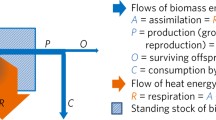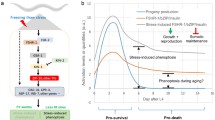Abstract
Survival to old age in natural populations is enhanced by high vitality and resilience which depends upon substantial homeostasis and energetic amd metabolic efficiency underlain by genes for stress resistance. Under this assumption increased longevity follows from primary selection for stress resistance where stress targets energy carriers. Furthermore old and young fitness should be correlate dirrespective of age under the stressful selection regime of natural populations. In contrast, antagonistic pleiotropy is most likely under the less rigorous selection regime of well-nourished humans and laboratory populations surviving to old age. Similarly, hormesis for longevity, for example from a mild temperature stress or restricted food intake is most likely under benign environmental conditions. Assuming that aging in natural populations depends upon ecological circumstances, large evolutionary increases in life span are unlikely under the stress theory of aging since organisms are frequently close to their limits of survival where metabolic efficiency is at a premium. Exceptions can occur in island populations and for mutants under laboratory conditions since the risks from environmental hazards are reduced, and life span becomes extended as a consequence. In modern human populations, selection for stress resistance is less intense than in earlier times which should be permissive of the accumulation of stress-sensitive mutants under the mutation-accumulation theory of aging. However, this process is ultimately likely to restrict the evolution of life-span extensions in the future especially if abiotic conditions deteriorate, when survival would depend more directly on metabolic efficiency under stress.
Similar content being viewed by others
References
Abrams PA and Ludwig D (1995) Optimality theory, Gompertz law, and the disposable soma theory of senescence. Evolution 49: 1055-1066
Allison DB, Fontaine KR and Cheskin LJ (2001) Metabolic disharmony and mortality. Med Hypotheses 56: 604-609
Arking R (2001) Gene expression and regulation in the extended longevity phenotypes of Drosophila. Ann NY Acad Sci 928: 157-167
Arking R, Burde V, Graves K, Hari R, Feldman E, Zeeve A et al. (2000) Forward and reverse selection for longevity in Drosophila is characterized by alteration of antioxidant gene expression and oxidative damage patterns. Exp Gerontol 35: 167-185
Austad SN (1993) Retarded senescence in an insular population of Virginia oposssums (Didelphis virginiana). J Zool London 229: 695-708
Austad SN (1997) Why We Age. New York, John Wiley Beckman KB and Ames BN (1998) Mitochondrial aging: open questions. Annals NY Acad Sci 854: 118-127
Boulétreau-Merle J, Fouillet P and Terrier O (1992) Clinal and seasonal variations in initial retention of virgin Drosophla melanogaster females as a strategy for fitness. Evol Ecol 6: 223-242
Buck S, Vettraino J, Force AG and Arking R (2000) Extended longevity in Drosophila is consistently associated with a decrease in developmental viability. J Gerontol 55A: B292-B301
Donahaye E (1993) Biological differences between strains of Tribolium castaneum selected for resistance to hypoxia and hypercarbia, and the unselected strain. Physiol Entomol 18: 247-250
Drapeau MD, Gass EK, Simison MD, Mueller LD and Rose MR (2000) Testing the heterogeneity theory of late-life mortality plateaus by using cohorts of Drosophila melanogaster. Exp Gerontol 35: 71-84
Finkel T and Holbrook NJ (2000) Oxidants, oxidative stress and the biology of ageing. Nature 408: 239-247
Fisher RA (1930) The Genetical Theory of Natural Selection. Clarendon Press, Oxford
Gerber LM, Williams GC and Gray SJ (1999) The nutrient-toxin dosage continuum in human evolution and modern health. Quart Rev Biol 74: 273-289
Gonos ES (2000) Genetics of aging: lessons from centenarians. Exp Gerontol 35: 15-21
Harman D (1956) Aging-a theory based on free radical and radiation chemistry. J Gerontol 11: 298-300
Harman D (2001) Aging: overview. Ann NY Acad Aci 928: 1-21
Harman D, Holliday R and Meydani M (eds) (1998) Towards prolongation of the healthy life span. Ann NY Acad Sci 854: 1-524
Harshman LG and Haberer BA (2000) Oxidative stress resistance: a robust correlated response to selection in extended longevity lines of Drosophila melanogaster? J Gerontol A55: B414-B417
Hayflick L (2000) The future of ageing. Nature 408: 267-269
Hercus M and Loeschcke V (2001) Comments to paper by S. Rattan: applying hormesis in aging research and therapy-a perspective from evolutionary biology. Human Exp Toxicol 20: 305-308
Hercus MJ, Loeschcke V and Rattan SIS (2001) The consequence of repeated mild heat stress exposures on fecundity and longevity in Drosophila. Funct Ecol (in press)
Hoffmann AA and Parsons PA (1993) Selection for adult desiccation resistance in Drosophila melanogaster: fitness components, larval resistance and stress correlations. Biol J Linn Soc 48: 43-54
Jazwinski SM (1999) Molecular mechanisms of yeast longevity. Trends Microbiol 7: 247-252
Jazwinski SM (2000) Metabolic control and ageing. Trends Genetics 16: 506-511
Kauffman SA (1993) The Origins of Order: Self-Organization and Selection in Evolution. Oxford University Press, New York
Kerber RA, O'Brien E, Smith BR and Cawthon RM (2001) Familial excess longevity in Utah longevities. J Gerontol 56A: B130-B139
Klingenberg CP and Spence TR (1997) On the role of body size for life-history evolution. Ecol Ent 22: 55-68
Kohane MJ (1988) Stress, altered energy availability and larval fitness in Drosophila melanogaster. Heredity 60: 273-281
Kondrashov AS and Houle D (1994) Genotype-environment interactions and the estimation of the genomic mutation rate in Drosophila melanogaster. Proc R Soc London B 258: 221-227
Lin Y-J, Seroude L and Benzer S (1998) Extended life-span and stress resistance in the Drosophila mutant methuselah. Science 282: 943-946
Lithgow GJ, White TM, Melov S and Johnson TE (1995) Thermotolerance and extended life-span conferred by single-gene mutations and induced by thermal stress. Proc Natl Acad Sci USA 92: 7540-7544
Łomnicki A and Jasieński (2000) Does fitness erode in the absence of selection? An experimental test with Tribolium. J Heredity 91: 407-411
Luckey TD (1991) Radiation Hormesis. CRC Press, Boca Raton, Florida
Luckinbill LS and Foley P (2000) Experimental and empirical approaches in the study of aging. Biogerontology 1: 3-13
Martin GM (2001) Frontiers of aging. Science 294: 13
Masoro EJ and Austad SN (1996) The evolution of the antiaging action of dietary restriction: a hypothesis. J Gerontol 51A: B387-B391
McClearn GE (1987) The many genetics of aging In:Woodhead AD and Thompson KH (eds) Evolution of Longevity in Animals: a Comparative Approach, pp 135-144. Plenum Press, New York
Miller RA (2001) Biomarkers of aging: prediction of longevity by using age-sensitive T-cell subset determinations in a middleaged, genetically heterogeneous mouse population. J Gerontol 56A: B180-B186
Minois N (2000) Longevity and aging: beneficial effects of exposure to mild stress. Biogerontology 1: 15-29
Mitrovski P and Hoffmann AA (2001) Postponed reproduction as an adaptation to winter conditions in Drosophila melanogaster: evidence for clinal variation under semi-natural conditions. Proc R Soc London B 268: 2163-2168
Mitton JB (1993) Enzyme heterozygosity, metabolism, and developmental variability. Genetica 89: 47-63
Nevo E, Filippucci MG and Beiles A (1994) Genetic polymorphisms in subterranian mammals (Spalax ehrenbergi superspecies) in the Near East revisited: Patterns and theory. Heredity 72: 465-487
Nevo E, Rashkovetsky E, Pavlicek T and Korol A (1998) A complex adaptive syndrome in Drosophila caused by microclimatic contrasts. Heredity 80: 9-16
Parsons PA (1980) Adaptive strategies in natural populations of Drosophila. Ethanol tolerance, desiccation resistance, and development times in climatically optimal and extreme environments. Theroret Appl Genet 57: 257-266
Parsons PA (1992) Evolutionary adaptation and stress: the fitness gradient. Evol Biol 26: 191-223
Parsons PA (1993) Evolutionary adaptation and stress: energy budgets and habitats preferred. Behav Genet 23: 231-238
Parsons PA (1995) Inherited stress resistance and longevity: a stress theory of ageing. Heredity 75: 216-221
Parsons PA (1996a) The limit to human longevity: an approach through a stress theory of ageing. Mech Ageing Dev 87: 211-218
Parsons PA (1996b) Rapid development and a long life: an association expected under a stress theory of aging. Experientia 52: 643-646
Parsons PA (1997) Stress-resistance genotypes, metabolic efficency and intrepreting evolutionary change In: Bijlsma R and Loeschcke V (eds) Environmental Stress, Adaptation and Evolution, pp 291-305. Birkhäuser Verlag, Basel
Parsons PA (1998) Behavioural variability and limits to evolutionary adaptation under stress. Adv Study Behavior 27: 155-180
Parsons PA (2000a) Hormesis: an adaptive expectation with emphasis on ionizing radiation. J Appl Toxicol 20: 103-112
Parsons PA (2000b) Caloric restriction, metabolic efficiency and hormesis. Human Exp Toxicol 19: 345-347
Puca AA, Daly MJ, Brewster SJ, Matise TC, Barrett J, Shea-Drinkwater M et al. (2001) A genome-wide scan for linkage to human exceptional longevity identifies a locus on chromosome 4. Proc Natl Acad Sci USA 98: 10505-10508
Rattan SIS (2001) Applying hormesis in aging research and therapy. Human Exp Toxicol 20: 281-285
Rogina B, Reenan RA, Nilsen SP and Helfand SL (2000) Extended life-span conferred by cotransporter gene mutations in Drosophila. Science 290: 2137-2140
Rose MR (1991) Evolutionary Biology of Aging. Oxford University Press, New York
Rose MR, Vu LN, Park SU and Graves JL Jr (1992) Selection on stress resistance increases longevity in Drosophila melanogaster. Exp Gerontol 27: 241-250
Schächter F (2000) The genetics of survival. Ann NY Acad Sci 908: 64-70
Schnebel EM and Grossfield J (1988) Antagonistic pleiotropy: an interspecific Drosophila comparison. Evolution 42: 306-311
Tatar M, Chien SA and Priest NK (2001) Negligible senescence during reproductive dormancy in Drosophila melanogaster. Am Nat 158: 248-258
Templeton AR, Hollocher H, Lawler S and Johnston JS (1990) In Barker JSF, Starmer WT and MacIntyre RJ (eds) Ecological and Evolutionary Genetics of Drosophila, pp 17-35. Plenum Press, New York
Toupance B, Godelle B, Gouyon P-H and Schächter F (1998) A model for antagonistic pleiotropic gene action for mortality and advanced age. Am J Hum Genet 62: 1525-1534
Van Valen L (1976) Energy and evolution. Evol Theory 1: 179-229
Vaupel JW (1988) Inherited frailty and longevity. Demography 25: 277-287
Vaupel JW, Carey JR, Christensen K, Johnson TE, Yashin AI, Holm NV et al. (1998) Biodemographic trajectories of longevity. Science 280: 855-860
Walker DW, Jenkins NL, Harris J and Lithgow GJ (2000). Evolution of lifespan in C. elegans. Nature 405: 296-297
White TCR (1993) The Inadequate Environment: Nitrogen and Abundance of Animals. Springer-Verlag, Berlin
Williams GC (1957) Pleiotropy, natural selection, and the evolution of senesence. Evolution 11: 298-411
Yashin AI, DeBenedictis G, Vaupel JW, Tan Q, Andreev KF, Iachine IA et al. (2000) >Genes and longevity: lessons from studies of centenarians. J Gerontol 55A: B319-B328
Yu BP and Chung HY (2001) Stress resistance by caloric restriction for longevity. Ann NY Acad Sci 928: 39-47
Author information
Authors and Affiliations
Rights and permissions
About this article
Cite this article
Parsons, P.A. Life span: does the limit to survival depend upon metabolic efficiency under stress?. Biogerontology 3, 233–241 (2002). https://doi.org/10.1023/A:1016271005967
Issue Date:
DOI: https://doi.org/10.1023/A:1016271005967




